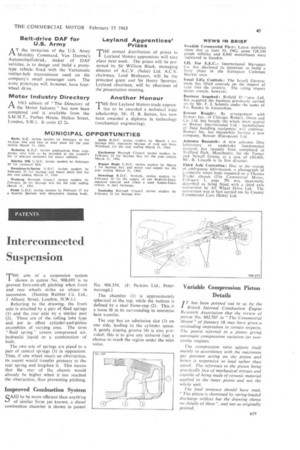Interconnected Suspension
Page 47

If you've noticed an error in this article please click here to report it so we can fix it.
"THE aien of a suspension system
shown in patent No. 908,693 is to prevent fore-and-aft pitching when front and rear wheels strike an object in succession. (Dunlop Rubber Co, Ltd., .1 Albany Street, London, N.W.1.)
Referring to the drawing, the front axle is attached by a pair of fluid springs (1) and the rear axle by a similar pair (2). These are of the rolling lobe type and are in effect cylinder-and-piston assemblies of varying area. The term "fluid spring" covers compressed air, hydraulic liquid or a combination of both.
The two sets of springs are piped to a pair of central springs (3) in opposition. Thus, if one wheel meets an obstruction, its ascent would transfer pressure to the rear spring and lengthen it, This means that the rear of the chassis would already be higher when it too reached the obstruction, thus preventing pitching.
Improved Combustion System
cAID to be more efficient than anything of similar form yet known, a diesel combustion chamber is shown in patent No. 904,339, (F, Perkins Ltd., Peterborough.) The chamber (1) is approximately spherical at the top, while the bottom is defined by a steel flame-cup (2). This is a loose fit in its surrounding to minimise heat transfer.
The cup has an admission slot (3) on one side, leading to the cylinder space. A gently sloping groove (4) is also provided; this is to give any unburnt fuel a chance to reach the region under the inlet valve.
Variable Compression Piston Details
T has been pointed out to us by the British Internal Combustion Engine Research Association that the review of patent No. 902,707 in "The Commercial Motor" of January 18 may have given a misleading impression in certain respects. The patent referred to a piston giving automatic compression variation for twostroke engines.
The compression ratio adjusts itself mainly in accordance with the maximum gas pressure acting on the piston and hence is responsive to load rather than speed. The reference to the piston being practically free of mechanical stresses and capable of being made of ceramic Material applied to the inner piston and not the whole unit.
The final sentence should have read, "The piston is shortened by spring-loaded discharge orifices but the drawing shows no details of these", and not as originally
printed. n29












































































































